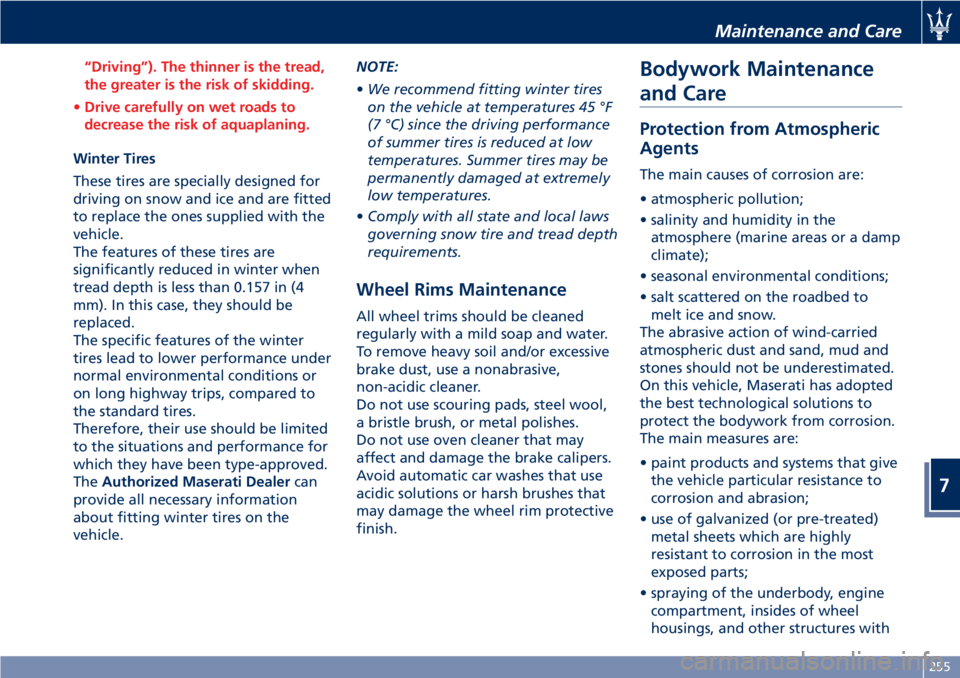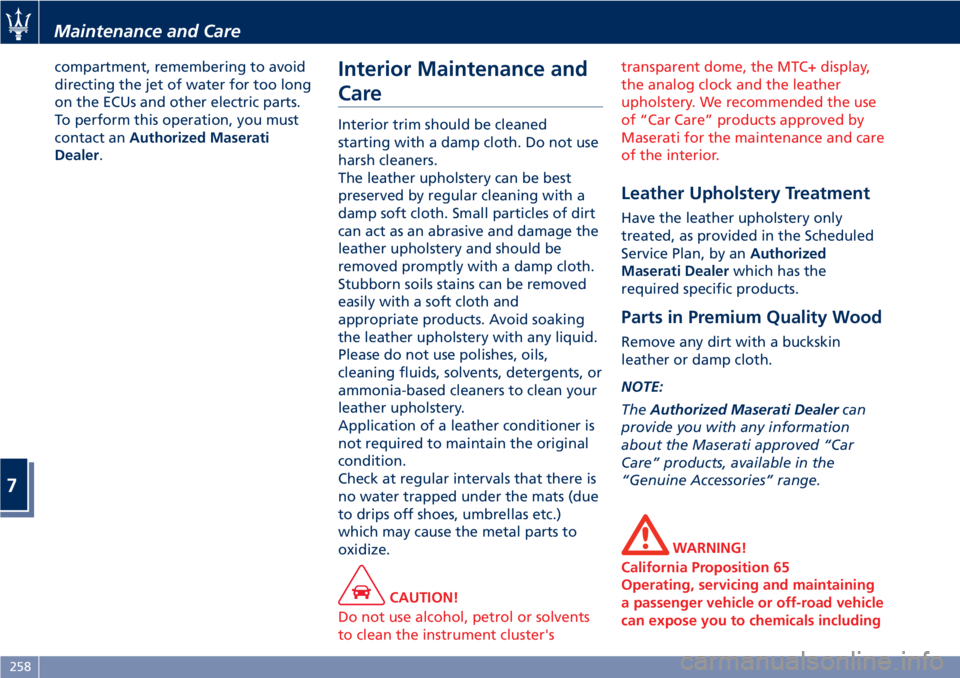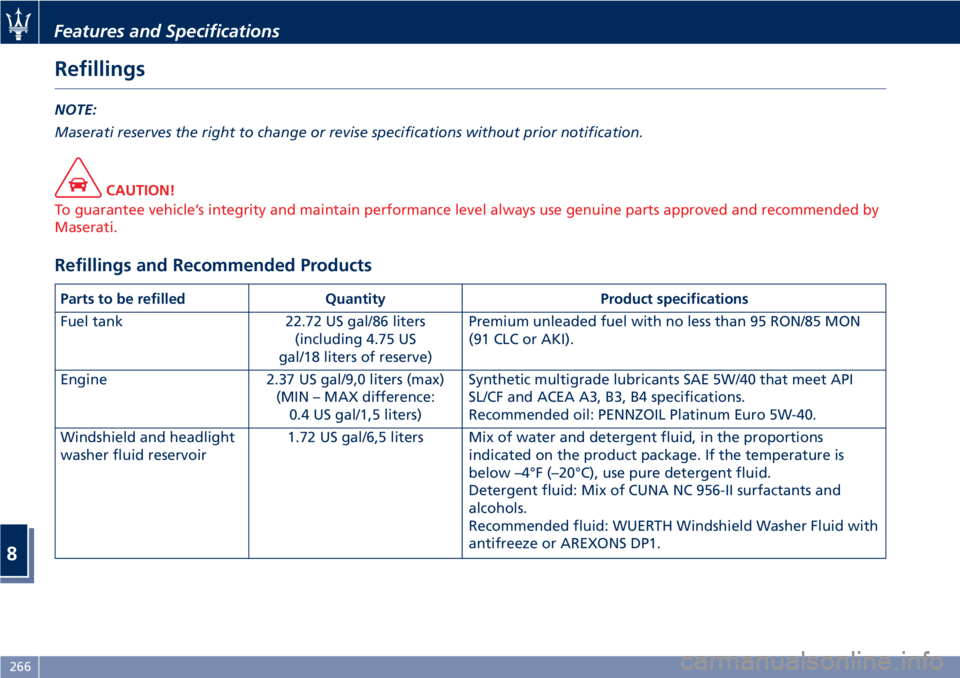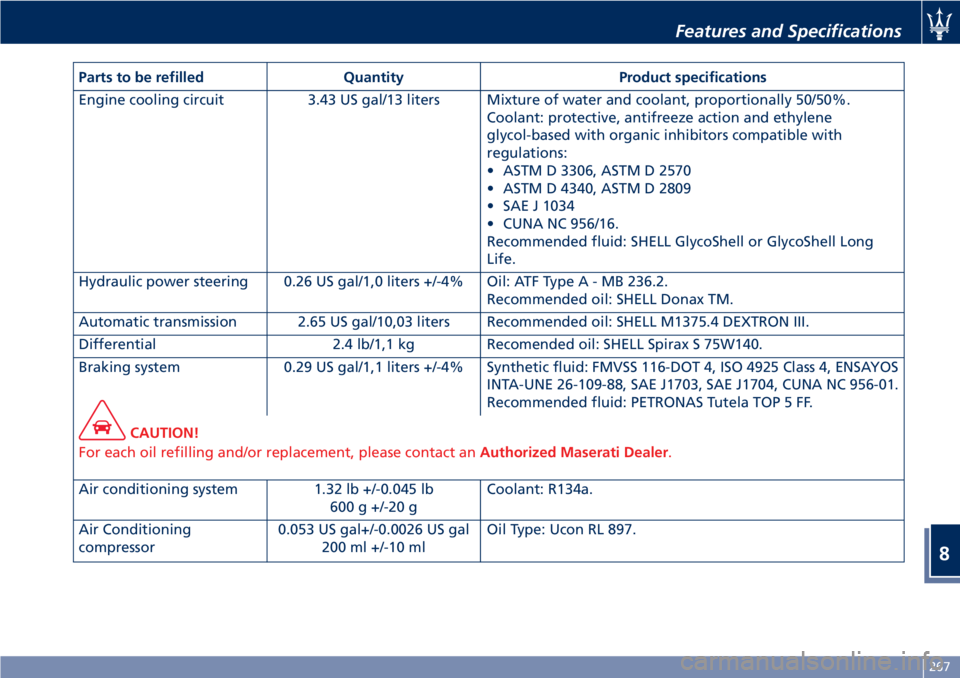2020 MASERATI GRANTURISMO oil
[x] Cancel search: oilPage 249 of 286

Passenger Compartment Fuses
Pos. Amp. –
ColorSystem / Component
F12 15 A –
BlueRight-hand low
beam
F13 15 A –
BlueLeft-hand low beam
F31 7.5 A –
BrownA/C unit, NBC (Body
Computer Node),
high beam relay
F32 10 A –
RedDomelights, step
lights, CAV, driver-
and passenger-side
footwell lights,
outside mirror lights
F33 30 A –
GreenDriver’s seat
(movement)
F34 30 A –
GreenPassenger’s seat
(movement)
F35 7.5 A –
BrownACC, FN and LF relay
coil
F36 10 A –
RedNQS
F37 10 A –
RedNQS (Instrument
Cluster Node), CPP,
CPD
F38 15 A –
BlueRear lid lock
Pos. Amp. –
ColorSystem / Component
F39 15 A –
BlueNIM (Inside Roof
Node), NCL (Air
conditioning and
heating system
node), OBD socket,
CSA (Alarm system
siren ECU), CAV
(Motion sensing
alarm ECU), radio,
NAVTRAK
F40 30 A –
GreenHeated rear window
F41 - Not used
F42 7.5 A –
BrownPower supply for
control panel on roof
F43 30 A –
GreenWindshield
wiper/washer
(Connected Devices
Relay INT/A)
F44 20 A –
YellowFront and rear power
outlets (INT/A device
relay) front seat
heating (passenger
side)
F45 - Not used
F46 20 A –
YellowNPG/NPP locksPos. Amp. –
ColorSystem / Component
F47 30 A –
GreenNPG (Driver’s door
node)
F48 30 A –
GreenNPP (Passenger’s
door node)
F49 7.5 A –
BrownNVO (Steering wheel
node), CSG (Power
steering ECU), CSP
(Twilight/rain sensor
ECU), NIM (Inside
Roof Node), NCL,
Radio, CEM, CRP,
domelight molding,
windshield wiper
controls, NAVTRAK
F50 7.5 A –
BrownAir bag system
F51 7.5 A –
BrownNCA (Automatic
Gearbox Node)
F52 15 A –
BlueFront seat heating
(driver side) (INT/A
device relay)
F53 10 A –
RedRear fog lights
Maintenance and Care
7
245
Page 259 of 286

“Driving”). The thinner is the tread,
the greater is the risk of skidding.
•Drive carefully on wet roads to
decrease the risk of aquaplaning.
Winter Tires
These tires are specially designed for
driving on snow and ice and are fitted
to replace the ones supplied with the
vehicle.
The features of these tires are
significantly reduced in winter when
tread depth is less than 0.157 in (4
mm). In this case, they should be
replaced.
The specific features of the winter
tires lead to lower performance under
normal environmental conditions or
on long highway trips, compared to
the standard tires.
Therefore, their use should be limited
to the situations and performance for
which they have been type-approved.
TheAuthorized Maserati Dealercan
provide all necessary information
about fitting winter tires on the
vehicle.NOTE:
•We recommend fitting winter tires
on the vehicle at temperatures 45 °F
(7 °C) since the driving performance
of summer tires is reduced at low
temperatures. Summer tires may be
permanently damaged at extremely
low temperatures.
•Comply with all state and local laws
governing snow tire and tread depth
requirements.
Wheel Rims Maintenance
All wheel trims should be cleaned
regularly with a mild soap and water.
To remove heavy soil and/or excessive
brake dust, use a nonabrasive,
non-acidic cleaner.
Do not use scouring pads, steel wool,
a bristle brush, or metal polishes.
Do not use oven cleaner that may
affect and damage the brake calipers.
Avoid automatic car washes that use
acidic solutions or harsh brushes that
may damage the wheel rim protective
finish.
Bodywork Maintenance
and Care
Protection from Atmospheric
Agents
The main causes of corrosion are:
• atmospheric pollution;
• salinity and humidity in the
atmosphere (marine areas or a damp
climate);
• seasonal environmental conditions;
• salt scattered on the roadbed to
melt ice and snow.
The abrasive action of wind-carried
atmospheric dust and sand, mud and
stones should not be underestimated.
On this vehicle, Maserati has adopted
the best technological solutions to
protect the bodywork from corrosion.
The main measures are:
• paint products and systems that give
the vehicle particular resistance to
corrosion and abrasion;
• use of galvanized (or pre-treated)
metal sheets which are highly
resistant to corrosion in the most
exposed parts;
• spraying of the underbody, engine
compartment, insides of wheel
housings, and other structures with
Maintenance and Care
7
255
Page 262 of 286

compartment, remembering to avoid
directing the jet of water for too long
on the ECUs and other electric parts.
To perform this operation, you must
contact anAuthorized Maserati
Dealer.Interior Maintenance and
Care
Interior trim should be cleaned
starting with a damp cloth. Do not use
harsh cleaners.
The leather upholstery can be best
preserved by regular cleaning with a
damp soft cloth. Small particles of dirt
can act as an abrasive and damage the
leather upholstery and should be
removed promptly with a damp cloth.
Stubborn soils stains can be removed
easily with a soft cloth and
appropriate products. Avoid soaking
the leather upholstery with any liquid.
Please do not use polishes, oils,
cleaning fluids, solvents, detergents, or
ammonia-based cleaners to clean your
leather upholstery.
Application of a leather conditioner is
not required to maintain the original
condition.
Check at regular intervals that there is
no water trapped under the mats (due
to drips off shoes, umbrellas etc.)
which may cause the metal parts to
oxidize.
CAUTION!
Do not use alcohol, petrol or solvents
to clean the instrument cluster'stransparent dome, the MTC+ display,
the analog clock and the leather
upholstery. We recommended the use
of “Car Care” products approved by
Maserati for the maintenance and care
of the interior.
Leather Upholstery Treatment
Have the leather upholstery only
treated, as provided in the Scheduled
Service Plan, by anAuthorized
Maserati Dealerwhich has the
required specific products.
Parts in Premium Quality Wood
Remove any dirt with a buckskin
leather or damp cloth.
NOTE:
TheAuthorized Maserati Dealercan
provide you with any information
about the Maserati approved “Car
Care” products, available in the
“Genuine Accessories” range.
WARNING!
California Proposition 65
Operating, servicing and maintaining
a passenger vehicle or off-road vehicle
can expose you to chemicals including
Maintenance and Care
7
258
Page 264 of 286

Restarting the Vehicle
Before restarting the vehicle after a
long period of inactivity, we
recommend that you carry out the
following operations.
• Check the tires for pressure and for
any damages, cuts or cracks. If this is
the case, have them replaced.
• Do not dry-rub the external surface
of the vehicle.
• Visually inspect if there are any fluid
leaks (oil, brake and clutch fluid,
engine coolant etc.).
• Have the engine oil and filter
replaced.
• Check the fluid levels in the brake
system, as well as the engine coolant
level.
• Check the air filter and have them
replaced if necessary.
• Reconnect the battery after checking
the charge status (refer to
“Maintenance-Free Battery” in this
section) and perform the initializing
procedure if applicable.
• With the transmission in N (Neutral),
let the engine idle for several
minutes.WARNING!
The engine idle must be performed
outdoors. Exhaust gases contain
carbon monoxide which is strongly
toxic and potentially lethal.
WARNING!
California Proposition 65
Operating, servicing and maintaining
a passenger vehicle or off-road vehicle
can expose you to chemicals including
such as, engine exhaust, carbon
monoxide, phthalates and lead, that
which are know to the State of
California to cause cancer and birth
defects or other reproductive harm. To
minimize exposure, avoid breathing
exhaust, do not idle the engine except
as necessary, service your vehicle in a
well-ventilated area and wear gloves
or wash your hands frequently when
servicing your vehicle. For more
information go to:
www.P65Warnings.ca.gov/passenger-
vehicle
Battery Statement
Battery Statement Status of
Charge
To avoid problems with ignition and/or
the electrical system in general when
you are driving, the battery charge
status is constantly maintained and
guaranteed by the vehicle's recharge
circuit; the main component of which
is the alternator. This circuit is only
able to supply voltage to the battery
when the vehicle is traveling.
The
warning light on the
instrument cluster (see “Instrument
Cluster” in section “Dashboard
Instruments and Controls”), will
indicate any malfunctions in the
recharge circuit or an insufficient
battery charge status (flashing).
The vehicle is fitted with advanced
electronic systems, such as, for
example, the alarm system and various
electronic control modules, which
consume power even when the key in
the ignition switch is in theSTOP (OFF)
position and the vehicle is not being
used.
Therefore, it is fundamental that the
battery is properly charged to ensure
that the engine starts properly and
Maintenance and Care
7
260
Page 270 of 286

Refillings
NOTE:
Maserati reserves the right to change or revise specifications without prior notification.
CAUTION!
To guarantee vehicle’s integrity and maintain performance level always use genuine parts approved and recommended by
Maserati.
Refillings and Recommended Products
Parts to be refilled Quantity Product specifications
Fuel tank 22.72 US gal/86 liters
(including 4.75 US
gal/18 liters of reserve)Premium unleaded fuel with no less than 95 RON/85 MON
(91 CLC or AKI).
Engine 2.37 US gal/9,0 liters (max)
(MIN – MAX difference:
0.4 US gal/1,5 liters)Synthetic multigrade lubricants SAE 5W/40 that meet API
SL/CF and ACEA A3, B3, B4 specifications.
Recommended oil: PENNZOIL Platinum Euro 5W-40.
Windshield and headlight
washer fluid reservoir1.72 US gal/6,5 liters Mix of water and detergent fluid, in the proportions
indicated on the product package. If the temperature is
below –4°F (–20°C), use pure detergent fluid.
Detergent fluid: Mix of CUNA NC 956-II surfactants and
alcohols.
Recommended fluid: WUERTH Windshield Washer Fluid with
antifreeze or AREXONS DP1.
Features and Specifications
8
266
Page 271 of 286

Parts to be refilled Quantity Product specifications
Engine cooling circuit 3.43 US gal/13 liters Mixture of water and coolant, proportionally 50/50%.
Coolant: protective, antifreeze action and ethylene
glycol-based with organic inhibitors compatible with
regulations:
• ASTM D 3306, ASTM D 2570
• ASTM D 4340, ASTM D 2809
• SAE J 1034
• CUNA NC 956/16.
Recommended fluid: SHELL GlycoShell or GlycoShell Long
Life.
Hydraulic power steering 0.26 US gal/1,0 liters +/-4% Oil: ATF TypeA-MB236.2.
Recommended oil: SHELL Donax TM.
Automatic transmission 2.65 US gal/10,03 liters Recommended oil: SHELL M1375.4 DEXTRON III.
Differential 2.4 lb/1,1 kg Recomended oil: SHELL Spirax S 75W140.
Braking system 0.29 US gal/1,1 liters +/-4% Synthetic fluid: FMVSS 116-DOT 4, ISO 4925 Class 4, ENSAYOS
INTA-UNE 26-109-88, SAE J1703, SAE J1704, CUNA NC 956-01.
Recommended fluid: PETRONAS Tutela TOP 5 FF.
CAUTION!
For each oil refilling and/or replacement, please contact anAuthorized Maserati Dealer.
Air conditioning system 1.32 lb +/-0.045 lb
600 g +/-20 gCoolant: R134a.
Air Conditioning
compressor0.053 US gal+/-0.0026 US gal
200 ml +/-10 mlOil Type: Ucon RL 897.
Features and Specifications
8
267
Page 272 of 286

WARNING!
California Proposition 65
Operating, servicing and maintaining
a passenger vehicle or off-road vehicle
can expose you to chemicals including
such as, engine exhaust, carbon
monoxide, phthalates and lead, that
which are know to the State of
California to cause cancer and birth
defects or other reproductive harm. To
minimize exposure, avoid breathing
exhaust, do not idle the engine except
as necessary, service your vehicle in a
well-ventilated area and wear gloves
or wash your hands frequently when
servicing your vehicle. For more
information go to:
www.P65Warnings.ca.gov/passenger-
vehicle
Engine Oil Identification
Symbol
This symbol means that the oil
has been certified by the
American Petroleum Institute
(API). Maserati only
recommends API Certified engine oils.
CAUTION!
Do not use chemical flushes in yourengine oil as the chemicals can
damage your engine. Damage caused
by use of non-approved chemicals is
not covered by the new Vehicle
Limited Warranty.
Engine Oil Viscosity (SAE
Grade)
SAE 5W-40 engine oil is recommended
for all operating temperatures.
The engine oil filler cap also shows the
recommended engine oil viscosity for
your engine. For information on
engine oil filler cap location, refer to
chapter “Maintenance Procedures” in
section “Maintenance and Care”.
Lubricants that do not have both the
engine oil certification mark and the
correct SAE viscosity grade number
should not be used.
Fuel Consumption
NOTE:
•The technical data, values and
specifications in this Owner’s Manual
are provided as guidance only. The
vehicle specific data can deviate from
the information provided, for
example, as a result of optional or
special equipment ordered with the
vehicle, vehicle loads, and country
specific measurement methods.
•The specifications described below
can change without prior
notification.
The fuel consumption values shown
(Miles Per Gallon - MPG) are
established using EPA test guidelines.
City:13MPG
Highway:21MPG
Combined:16MPG
Features and Specifications
8
268
Page 274 of 286

Engine Data
Cylinder number and position 8 - 90° V
Number of valves per cylinder 4
Bore x stroke 94 x 84,5 mm
Total displacement 4691 cu.cm
Compression ratio 11.2 +/- 0.2 : 1
Maximum power output (EC) (*) 338 kW – 460 CV
- corresponding rpm 7000 rpm
Maximum torque (EC) 520 Nm – 53 kgm
- corresponding rpm 4750 rpm
(*) Values obtained in SPORT drive mode with 98 R.O.N.
Timing SystemThe timing system uses two overhead camshafts. The
camshafts are equipped with timing variator. The timing
control is done by two chains.
Lubrication
SystemThe lubrication system is controlled by the wet sump system
through an oil pump and the relative suction screen,
incorporated in the crankcase.
Cooling SystemEngine cooling is ensured by an anti-freeze mixture
circulating inside a circuit equipped with radiator,
centrifugal pump and expansion tank.
Injection –
Ignition SystemHigh-pressure direct fuel injection system. Static ignition
with digital electronic control system included and
controlled by a single microprocessor ECU.
Features and Specifications
8
270